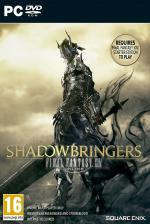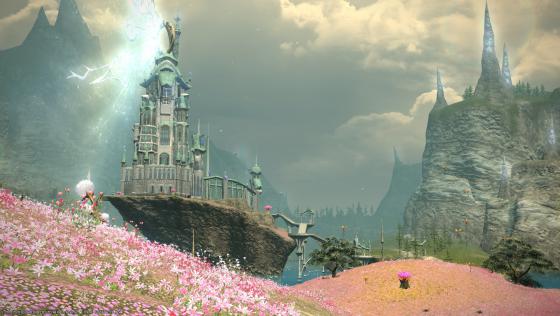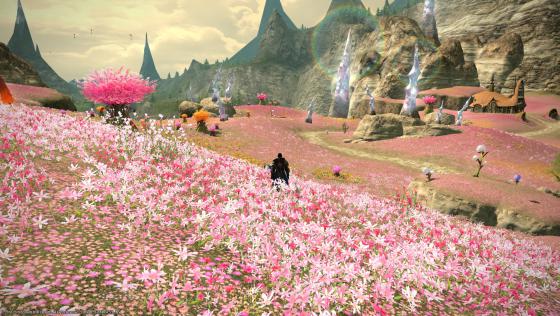
US Gamer
 9th July 2019
9th July 2019
Author: Mike Williams
Publisher: Square Enix
Machine: PC (Windows)
Now, this is a story all about how, our life got flipped-turned upside down.
Final Fantasy XIV: Shadowbringers
Over these past two weeks, I've been pondering, "What makes a Final Fantasy game a Final Fantasy game?" Is it just a name you can slap on anything? Is it that odd mix of fantasy, science fiction, and religious myth? Perhaps it's the surface elements: the Chocobos, Black Mage hats, and Maybe it's the angelic and demonic demi-god super villain pontificating on the nature of reality while they hit you with the magic equivalent of the Big Bang. Maybe it's just the hot and fashionable twenty-somethings wielding impossible weapons. I don't have the answer to that question, and I'm sure we'll still be discussing it in internet firestorms 30 years from now.
As the credits rolled on Final Fantasy XIV: Shadowbringers, I can say that it was probably the most "Final Fantasy" storyline this game has had. A Realm Reborn's storyline was more concerned with explaining the massive upheaval from the launch version. Heavensward leaned heavily into more standard medieval European fantasy and court politics. Stormblood was the tale of revolution and liberation. The two expansions were fantastic storylines, but I wouldn't necessarily say they're very "Final Fantasy." It's a feeling.
Who's On First?
Shadowbringers sends your character, the Warrior of Light, to another dimension. ("Shard" in the game's terminology.) An ancient conflict saw the world separated into thirteen shards, with your original world being The Source. Your adventure takes you to the First, a world where overflowing Light has destroyed most of civilization, with only a small contingent of city states surviving. In the First, it's always daytime, and the Light itself has a corrupting essence, turning the populace in angelic creatures called Sin-Eaters. As the Warrior of Light, you're the only thing that can fight the Light itself and restore Darkness to the world. It's an interesting flip on a basic trope-Light vs. Darkness-that feeds into everything that has previously happened with your character.
The unique situation of the First allows the Final Fantasy XIV team the chance to recontextualize areas that players are already familiar with. It's the same world sent down a different divergent path; the environments aren't exactly the same, but if you know what to look for, there's some fun connections. The ruined Crystal Tower is the shining city of the Crystarium in the First. The decadent pleasure palace of Eulmore is a version of Limsa Lominsa. The deserts of Thanalan are Amh Araeng in this new world, where the Flood of Light was ultimately stopped.Visually, there are some amazing standouts. I've always been a little disappointed in Final Fantasy XIV's normal environments, because they're quite grounded overall. I tend to prefer when a region is more fantastic and outlandish more, like the Binding Coil or Omega raids. You have the ability to create fantasy worlds that blow minds, so forests and plains don't entirely do it for me. Even playing around with the colours is enough.
With Shadowbringers, they're stretching that a little more. Lakeland is your first introduction to this world; it's a vibrant purple forest that leads to the magnificent crystal tower at the center of the Crystarium. Il Mheg, the land of the fairies, is a land of diamond spires that reflect the sunlight and bright fields of flowers as far as the eye can see. In its lake, there's the lost remnants of the previous civilization, and even they're a joy to swim through and look at. And once you get into the latter two levels of content, Shadowbringers jumps from strength to strength visually.
Dance Like You Mean It
The new jobs are the bigger deal, with Shadowbringers adding Gunbreaker and Dancer to the mix. The Gunbreaker is a tank role job, focused around the gunblade weapon first introduced in Final Fantasy 8. The Gunbreaker attacks to charge aether cartridges, which they then spend on stronger attacks and interesting combos. The expansion sees some changes in the existing jobs, bringing tanks and healers closer together. I'd say this makes Gunbreaker stand out a bit less. The job's animations and gear are standouts, but from what I played, I feel the damage isn't as high as Warriors, and the survivability isn't as high as Paladins. Gunbreaker is viable, but it doesn't particularly excel in any one area.
Dancer on the other hand is quite strong. This job hails from Final Fantasy 5, using complex dance steps to damage enemies. While there's a focus on various combos of dance steps, the Dancer relies heavily on procs, moves that have a chance to activate. Basically, you have to keep track of what moves are available to you at any one moment on the battlefield. The Dancer is a damage dealer, but it also has the ability to buff party members, providing small heals or bonuses to critical rates. All in all, it feels like a better version of fellow musically-inclined job, the Bard. It's probably a bit too powerful at this point, and I expect Square Enix will pull it back in future patches.
The overall changes in existing jobs push the game in slightly a different direction. There's more of a focus on area-of-effect (AOE) attacks, with every job having a firm AOE combo and many AOE abilities now costing nothing. Eminity (read: aggro) is also much easier for tanks to dish out, meaning DPS has more of a chance to go wild. This is similar to the shift in play style that World Of Warcraft saw in Wrath of the Lich King, where it became far easier to AOE whole groups of targets down, rather than whittling down specific targets. How you feel about that change is ultimately up to you, as I know some feel it removes some skill from running dungeons and trials.The new Trust system is really an expanded version of the Squadron mechanic introduced in Stormblood, allowing a single player to run dungeons alone, backed up by your AI-driven friends in the Scions of the Seventh Dawn. You'll eventually have a total of six members to choose from, each with a set tank, damage, or healing role. Once you complete the main scenario, the Trust system becomes even more like Squadrons, letting you level each character up.
There are limitations to the system though. You'll still have to jump into the Duty Finder and join a party of eight players to finish off Shadowbringers' three trials. Furthermore, while the Trust characters are remarkably good at avoiding boss attacks, there's no way to optimize them. You can't choose which attacks they use, and you can't get them to focus on specific targets. Sometimes, you might want them to attack one enemy in a pull, only for them to spend their time working on another. Also, it'd be nice for the system to span further backward to older dungeons, but I assume that requires additional programming on Square Enix' part.
A Tale of Two Cities
The previously-mentioned Eulmore is a city surrounded by a literal slum, where the poor throw themselves at the mercy of the rich within. They become slaves, working until they're discarded and killed, while the affluent enjoy their games of chance and lavish food. It's lorded over by a large blonde man who thinks he is a god, and tells the populace that they can co-exist with the monsters destroying their world. Eulmore opposes the Crystarium, a city where the refugees from other regions congregate together. Or there's the small settlement of those corrupted by the light, who wall themselves off to protect others, knowing they'll eventually become Sin-Eaters themselves. The opening salvo of Shadowbringers is where you're more apt to find connections to real-world situations and ideologies.
It gives way eventually to the more fantastical adventure, the more "Final Fantasy" one. But even here, the story is moored in something human. Your quest to bring Darkness to the First is contrasted by the previous failure of Ardbert, the Warrior of Darkness and your counterpart. Ardbert is a shade that only you can see, and you walk in his footsteps, succeeding where he and his team erred. Your end get the chance to step into their shoes for a brief moment during the campaign. You're saving a world yes, but you're also saving Ardbert's soul.
There's more I could gush about, but I'm trying to preserve the surprise for those that want to experience it for themselves. Shadowbringers ends up as the most satisfying of Final Fantasy XIV's tales, which is frankly a high bar to clear. Natsuko Ishikawa stepped in as the main scenario writer for this expansion, and she did a fantastic job.Presentation Is Everything
Shadowbringers' adventure is enhanced by the aural side of the equation. Outside of the battle theme-a hard rock tune I didn't enjoy-the soundtrack actually stands as the best in the series as well. The boss battle theme is simply wonderful and there's an alternate piano-heavy version of it, but it's also backed up by tunes like the Dancer theme "Vamo Alla Flamenco," the rousing theme of the final main scenario dungeon, and the final boss theme. Composer Masayoshi Soken always does a great job, but I feel like he's outdone himself here. I don't notice most soundtracks-it's my blindspot-but somehow his work makes me pay attention.
There's also more voice acting in this expansion than previous ones, and it's mostly great. There's a whole lot of British English and European voices, culminating in the hard Scottish twang of fae companion Feo Ul. The combination of a great story, solid voice acting, and a fantastic soundtrack adds up to what ends up being an emotional experience. Square Enix even got me choked up sometimes.
Ever since Heavensward, Final Fantasy XIV has been on a roll. Not everything is always the best of the best-Stormblood's post-release story content felt like a bit of a slog-but overall, FF14 remains one of the biggest MMOs on the market. It continues to grow, because it's clear that Square Enix knows what it does well and executes on that. The past two expansions were great, but the storytelling and "Final Fantasy" feeling of Shadowbringers puts it above the rest. If there wasn't such a long road to get to this point, I'd say this is the one Final Fantasy fans should jump on if they have yet to touch Final Fantasy XIV.
Verdict
Final Fantasy XIV set a high bar with its previous expansions, but Shadowbringers stands above the rest. Expected additions come in the form of new regions and the new jobs, Dancer and Gunbreaker. Both bring their own flavour to the game, though the Dancer is the standout. More importantly, Shadowbringers tells a tale that not only contains some meaningful real-world connections, but also provides an experience that's firmly Final Fantasy-esque. Great writing, solid voice acting, and an excellent soundtrack wrap Shadowbringers up in a package that should satisfy Final Fantasy XIV fans and neophytes alike.















